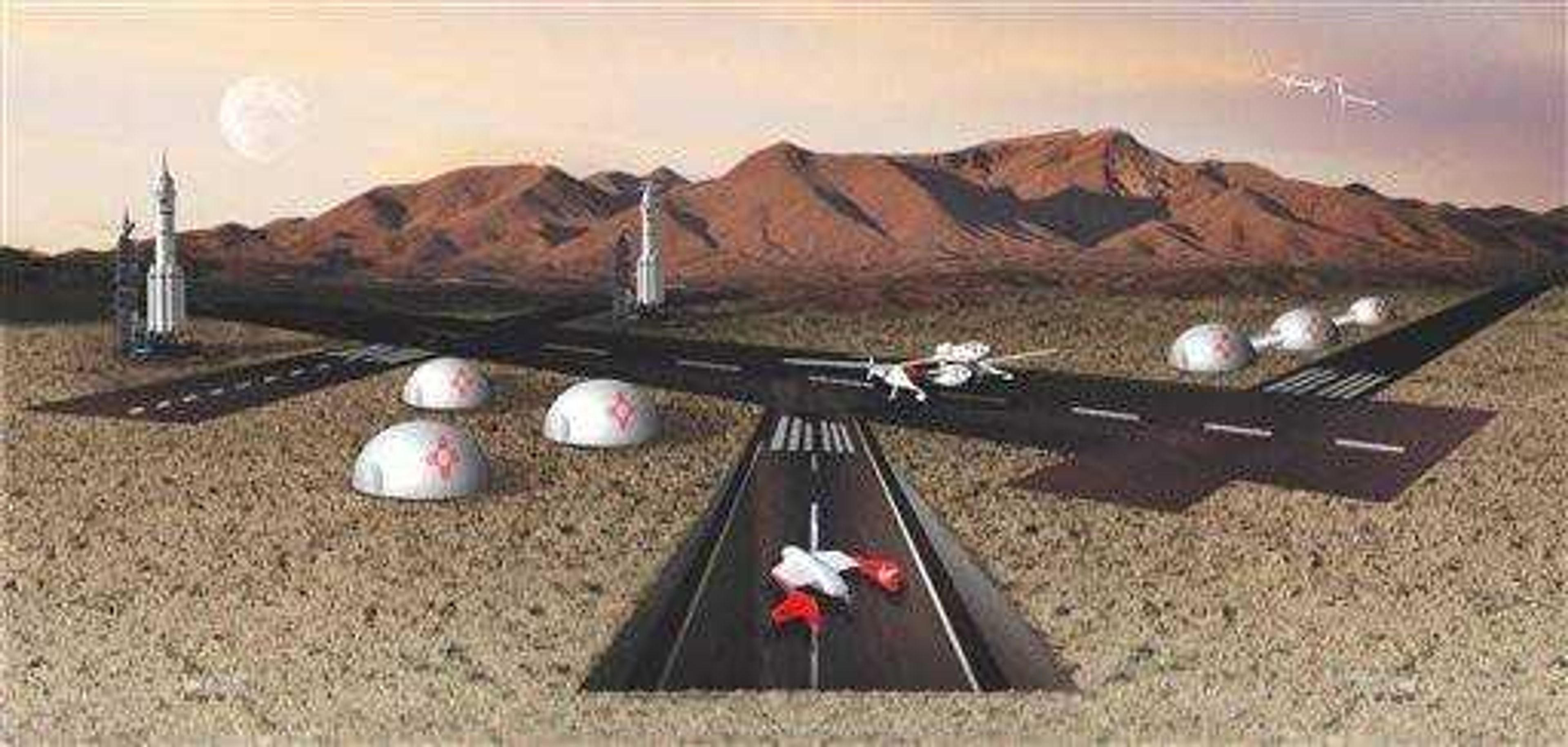States again considering the spaceport business
LOS ANGELES -- The promise of blasting thrill-seeking tourists into space is fueling an unprecedented rush to build snazzy commercial spaceports. The Federal Aviation Administration is reviewing proposals from New Mexico, Oklahoma and Texas to be gateways for private space travel. Depending on how environmental reviews and other requirements go, approval could come as early as this year and the sites could be ferrying space tourists soon after...
~ Technology may have finally caught up with starry-eyed plans.
LOS ANGELES -- The promise of blasting thrill-seeking tourists into space is fueling an unprecedented rush to build snazzy commercial spaceports.
The Federal Aviation Administration is reviewing proposals from New Mexico, Oklahoma and Texas to be gateways for private space travel. Depending on how environmental reviews and other requirements go, approval could come as early as this year and the sites could be ferrying space tourists soon after.
The current spaceport boom recalls the mid-1990s, when the first spaceport fad generated hype but no real construction. Finally, technology may have caught up with starry-eyed plans.
Aerospace designer Burt Rutan, who is building a commercial spaceship fleet for British space tourism operator Virgin Galactic, recently expressed his amazement at the flurry of proposals.
"It's almost humorous to watch the worldwide battle of the spaceports," Rutan mused earlier this month at the International Space Development Conference.
For decades, spaceports have been used mostly by NASA and the Pentagon to rocket astronauts and satellites into orbit.
Traditional launch ranges are often spartan mixes of lonely launch pad towers, concrete runways and aircraft hangars. Many are in remote coastal areas -- Florida's Cape Canaveral being the best known -- so that debris won't hit populated areas.
Requires a gamble
The current spaceport boom promises futuristic complexes that evoke the Jetsons. But cashing in requires a gamble.
None of the private rockets under development has been test-flown. And even once the FAA licenses any vehicles, the infant industry initially won't boast multiple daily flights -- at $100,000 to $250,000 a head, the market is decidedly limited.
For states that invest early, however, the long-term economic benefits could be substantial. A recent study commissioned by New Mexico predicted that its proposed hub could net $750 million in revenue and up to 5,800 new jobs by 2020. States with spaceports anchored by a reliable spaceliner and designed like a galactic Disneyland also could be a magnet for high-skill, high-wage labor and sprout cottage industries.
The rush to build commercial space hubs is spurred by entrepreneurs who want to send rich passengers into suborbital space -- a region about 60 miles above Earth. Several will build their rockets this summer with tentative plans to fly as early as next year pending regulatory approval.
New Mexico, which inked a deal with Virgin Galactic last year to construct a $225 million spaceport on 27 square miles of desert, is expected to select a winning architectural design from six entries on June 2.
While details of the spaceport designs are secret until a winner is chosen, tentative plans call for a complex built mostly underground. The facility, which would be funded by a mix of federal, state and local money, could open in late 2009. Virgin would have a 20-year lease on the facility.
Until then, Virgin Galactic, founded by British mogul Richard Branson, plans to fly the first passengers from California's Mojave Airport, where the Rutan-designed SpaceShipOne became the first privately manned rocketship to reach space in 2004.
Outside the seven government-run launch ranges, the Mojave hosts one of five nonfederal licensed spaceports in the U.S. that serve both commercial and government interests. The nonfederal ports are either state or privately operated.
Another space tourism operator, Rocketplane Kistler, wants to launch from the Oklahoma Spaceport. Still pending FAA approval, that spaceport sits on the site of the former Clinton-Sherman Airpark in Burns Flats and boasts one of the world's longest runways.
The Oklahoma Spaceport has passed all its requirements and is expected to win an FAA license over the next several weeks, said Bill Khourie, executive director of the Oklahoma Space Industry Development Authority.
Mission control is being upgraded and there are plans for VIP lounges and other amenities.
"We ultimately plan on building more sexy facilities," said Charles Lauer, vice president of business development at Rocketplane Kistler.
The FAA also is considering two proposed spaceports in Texas, including a private spaceport on 165,000 acres of desolate ranch land about 120 miles east of El Paso bought by Amazon.com founder Jeff Bezos. Bezos had said his space tourism firm, Blue Origin, would first build basic structures, then begin flight tests in six to seven years.
To gain a spaceport license, a facility must pass an environmental review and prove that its location won't harm surrounding communities or the public, said Patricia Grace Smith, associate administrator of the FAA Office of Commercial Space Transportation. Spaceports and launch vehicles are licensed separately.
The 1990s saw a different spaceport race.
Back then, New Mexico, Oklahoma and Texas were among more than a dozen states that squandered thousands of dollars trying to woo a much-hyped experimental spacecraft program.
VentureStar, a wedge-shaped spaceship by NASA and Lockheed Martin, was supposed to replace the space shuttle. But the program was plagued by engineering problems and was scrubbed in 2001.
To avoid another bust, commercial space hubs must find creative ways to supplement tourists' weightless experience by adding attractions such as theme parks, hotels and restaurants, said Derek Webber, director of Spaceport Associates, a Maryland-based consulting firm.
"You've got to do your homework," he said, "because not all states will succeed."
On the Net
Connect with the Southeast Missourian Newsroom:
For corrections to this story or other insights for the editor, click here. To submit a letter to the editor, click here. To learn about the Southeast Missourian’s AI Policy, click here.









